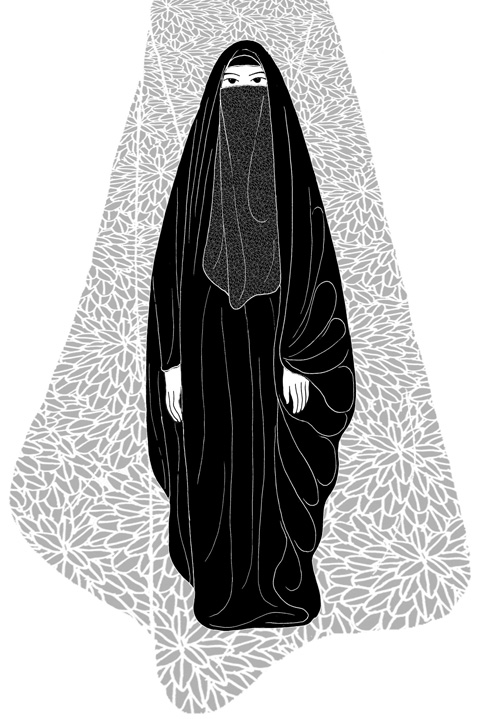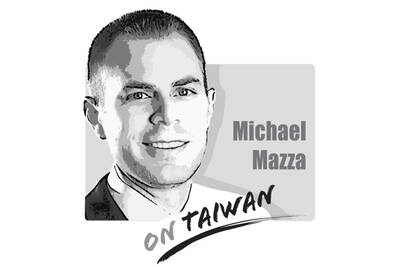Fashion week in Paris and after a display of pink and purple mini-dresses in an elegant apartment near the presidential palace, an assistant wheels out a rack bearing two very different creations: black abaya.
The billowing gowns to cover the body have been made for the Saudi market by Paris-based couturier Adam Jones.
As France considers banning full facial veils such as the niqab and the full cloak and veil or burqa, which French President Nicolas Sarkozy has said is not welcome in the country, the fact that it is a major exporter of couture abaya may seem odd.

But that is just one of the many contradictions exposed by the latest clash between secularism and religion in the home of Europe’s largest Muslim community.
“If someone tells me, ‘design an abaya,’ why not, I’m proud of that. It’s just a garment,” haute couture designer Stephane Rolland, who has made many abaya for Middle Eastern clients, said backstage after his fashion show in Paris.
When asked about the broader debate whether veils are a sign of subservience and should be outlawed, his confidence wavered.
“I don’t want to speak about religion, that’s a different subject. But I don’t want to cover the woman — alas, I don’t want to think about that,” he said before turning away.
While French designers are wooing Saudi clients in airy showrooms, across town in the working-class neighborhood of Belleville the picture is very different.
“If you wear the veil, you get insulted and attacked all the time, you get called a terrorist,” said Ikram Es-Salhi, a 20-year-old student standing outside the Zeina Pret-A-Porter shop that sells mass-produced headscarves, tunics and abaya.
‘ISLAMOPHOBIA’
Es-Salhi wears a long brown veil that covers her head and body but leaves her face open. She would like to wear the full niqab, but it is banned at her college.
She already switched from her preferred course of study, nursing, to languages and sociology as nurses are not allowed to wear veils.
She and her friend Aichatou Drame, who wears an ample white headscarf, decided to veil themselves three years and two weeks ago, respectively.
Their families were against it, worrying it will cause them trouble.
Many feminists not only in the West see the veil as an expression of a spreading ideology that wants to hide and silence women, undoing years of struggle for women’s rights.
But as educated French women from immigrant families, Es-Salhi and Drame reject the notion that this debate is about women’s rights.
“The real reason for this is Islamophobia,” said Es-Salhi, trembling with anger. “There are a lot more sisters who are wearing the veil now. If the niqab is banned, they will just stay at home or emigrate to the US, to Britain, to Morocco.”
For them, the main problems of Muslim women in France are not the veil but discrimination and unemployment among young people from immigrant families.
France does not release data on unemployment for certain ethnic groups, but the Organization for Economic Co-operation and Development in May highlighted discrimination against youths of North African and black African origin as a major problem in its labor market.
Others see the full veil itself as a problem.
Ni Putes Ni Soumises (“Neither Whores nor Submissives”), an organization promoting women’s rights in France’s multi-ethnic suburbs, has called the burqa an “open-air prison” and said extremists were taking women’s bodies hostage.
Mayors from various French cities have said more veiled women are turning up at wedding ceremonies or at schools to pick up their children, refusing to bare their faces even for identification.
There are no official statistics, but the anecdotal evidence was enough to prompt parliament to start a six-month inquiry into the spread of the niqab and the burqa this month.
TESTING THE REPUBLIC?
“Make no mistake, the burqa is a political debate, not a religious one. Extremists are once again testing the Republic,” said Jean-Francois Cope, a senior member of the ruling UMP party, in an interview with Le Parisien newspaper.
Several UMP members want it banned.
The row is reminiscent of a debate over headscarves worn in state schools, which resulted in a ban in 2004 based on the separation between state and religion.
As then, the debate itself has grown far beyond the problem that sparked it. The powder-blue Afghan burqa, a tent-like garment that covers women from top to toe, is in fact rare here, and even the niqab is not often seen.
At Zeina Pret-A-Porter, the shopkeeper says very few customers buy it, though she readily retrieves a typical cloth niqab and demonstrates how it is worn: either with one layer covering the face, leaving a slit for the eyes, or with two layers down, so the eyes are hidden behind black gauze.
From the outside, the full niqab presents an impenetrable black front. From the inside, the gauze allows a limited view of the world.
But even those who find the garment odious do not necessarily believe a ban is the best way to get rid of it.
In Afghanistan, where the Taliban once ordered women to cover up, Suraya Pakzad, executive director of the Voice of Women organization, says she agrees with Sarkozy’s view that the burqa is a bad thing, but disagrees with his conclusion.
“I am against the burqa being imposed by force. But what Mr Sarkozy is saying is another type of enforcement on women. No one should be able to compel someone to dress in a certain way,” she said.
The US Senate’s passage of the 2026 National Defense Authorization Act (NDAA), which urges Taiwan’s inclusion in the Rim of the Pacific (RIMPAC) exercise and allocates US$1 billion in military aid, marks yet another milestone in Washington’s growing support for Taipei. On paper, it reflects the steadiness of US commitment, but beneath this show of solidarity lies contradiction. While the US Congress builds a stable, bipartisan architecture of deterrence, US President Donald Trump repeatedly undercuts it through erratic decisions and transactional diplomacy. This dissonance not only weakens the US’ credibility abroad — it also fractures public trust within Taiwan. For decades,
In 1976, the Gang of Four was ousted. The Gang of Four was a leftist political group comprising Chinese Communist Party (CCP) members: Jiang Qing (江青), its leading figure and Mao Zedong’s (毛澤東) last wife; Zhang Chunqiao (張春橋); Yao Wenyuan (姚文元); and Wang Hongwen (王洪文). The four wielded supreme power during the Cultural Revolution (1966-1976), but when Mao died, they were overthrown and charged with crimes against China in what was in essence a political coup of the right against the left. The same type of thing might be happening again as the CCP has expelled nine top generals. Rather than a

The ceasefire in the Middle East is a rare cause for celebration in that war-torn region. Hamas has released all of the living hostages it captured on Oct. 7, 2023, regular combat operations have ceased, and Israel has drawn closer to its Arab neighbors. Israel, with crucial support from the United States, has achieved all of this despite concerted efforts from the forces of darkness to prevent it. Hamas, of course, is a longtime client of Iran, which in turn is a client of China. Two years ago, when Hamas invaded Israel — killing 1,200, kidnapping 251, and brutalizing countless others
A Reuters report published this week highlighted the struggles of migrant mothers in Taiwan through the story of Marian Duhapa, a Filipina forced to leave her infant behind to work in Taiwan and support her family. After becoming pregnant in Taiwan last year, Duhapa lost her job and lived in a shelter before giving birth and taking her daughter back to the Philippines. She then returned to Taiwan for a second time on her own to find work. Duhapa’s sacrifice is one of countless examples among the hundreds of thousands of migrant workers who sustain many of Taiwan’s households and factories,